The Tho people in Nhu Xuan district have always been united and lived in harmony, loving and supporting each other, creating a beautiful tradition in community life. Many good customs and traditions about relationships and behaviors between people and between people and nature have been passed down from generation to generation, becoming a way of life and beautiful behaviors in the community.
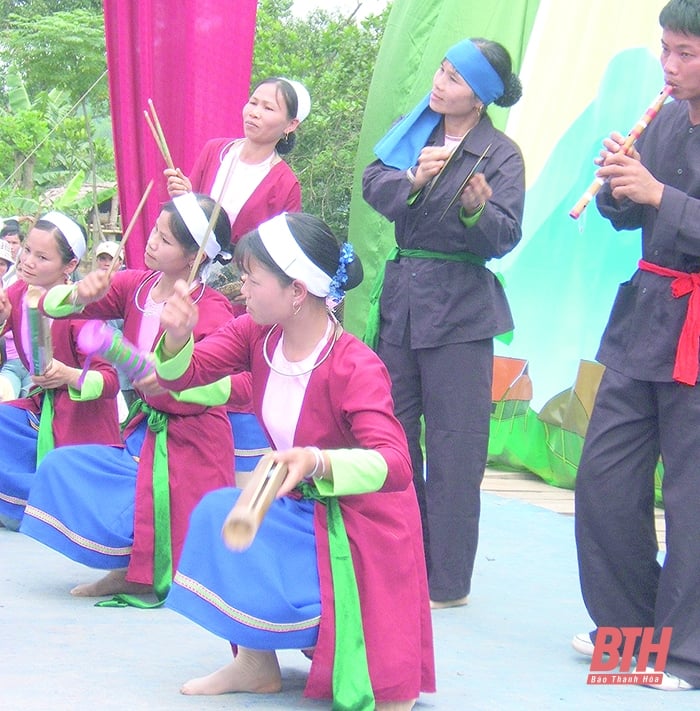
The folk culture of the Tho people is quite rich. There are a number of myths, legends, stories, poems, folk songs, proverbs, idioms... although there is cultural exchange with the Kinh and Muong ethnic groups, it still has its own unique nuances.
Music is also used by the Tho people in festivals, love songs, and love exchanges. The Tho people are proficient in using the mouth harp, flute, trumpet, and clay drum. In particular, gongs are used in daily life. This traditional musical instrument combined with drums is used in festivals, welcoming guests, celebrating a new house, celebrating the birth of a child, used in weddings, singing between men and women, and sending the deceased to their grandparents and ancestors.
The Tho people have a rich folk song heritage with many genres and melodies... reflecting the souls and feelings of the people here with their optimism, love of life, love of the forests, streams, fields, fields... the people and the landscapes that have been dearly attached to them for generations. Although life is still difficult, their songs and voices do not lose their deep and passionate affection.
Tho Nhu Xuan people love culture, arts, and are passionate about singing to forget the hardships and difficulties of daily working life. They sing while going to the fields, down to the high and low fields; sing while threshing rice, pounding rice, pounding green rice; sing lullabies to put their children to sleep, sing love songs to send their love and remembrance to the people they love and admire. They sing anytime, anywhere: in the forest, in the house, sing on moonlit nights, sing during festivals, and sing not only when they are happy but also when they are sad to ease their empty and lonely souls.
Folk songs of the Tho people are quite rich in form as well as content and performance. Lullabies are one of the popular singing styles, from old to young, from men to women. Lullabies not only put babies to sleep, but through the warm and passionate lullabies of their parents, grandparents, and older siblings, help children get acquainted with and come to the natural world with familiar animals: Oh....oh....oh.../ Oh...oh...la.../ The short-cut fish/ The short-tailed fish.../ Criticizing the tadpole frog/ The crooked-hearted horse hoof/ The close-knit bee/ Praising the hard-working bee/ Listening to the crow's husband/ Listening to the crow taking care of its chicks/ Carrying its chicks flying to the sky/ Where the deer go downhill/ Clearing the fields, the fields/ On this side of the field/ The bananas are ripening yellow/ The jackfruit is ripe red/ Chopping a branch of mulberry/ Chopping three branches of starfruit leaves...
Lullabies by the hammock lull babies into a deep sleep, taking children into a magical world and fairy tales, don't cry: Sleep for dad to go to the fields/ Sleep for mom to go to the fields...
Singing nursery rhymes is also remembered and memorized by many people, not only that, they are also the creators of these nursery rhymes. Nursery rhymes are not only popular for children, but this type of singing is also sung with great passion by adults: ...Want to drink well water/ Go to the canal/ Want to drink fence water/ Go to the copper tree/ Red royal poinciana flowers/ Cicadas sing/ Climb the tangerine tree/ Catch the brown beetle/ A pair of red-whiskered bulbuls/ Jump from branch to branch/ Sweet banana flowers/ Call the flock of woodpeckers/ A pair of doves/ Tickle each other in the alley/ It's slow, ho.
In the folk songs of the Tho people, the antiphonal singing has become popular and is always sung between a man and a woman or one side is a man and the other side is a woman. They sing between people in the same village and often between people from one village and people from another village. Antiphonal singing has many contents such as: singing to praise the beautiful scenery of the homeland and country, singing to tell the merits of national heroes, showing gratitude to ancestors, singing to invite betel, singing to ask questions, singing to guess, singing to pound rice, singing to swear, singing to distance, singing to blame... expressing many levels of feelings between men and women, couples. Loving each other regardless of distance/ We can wade through deep streams, cross rapids/ When we come here, we stay here/ When the roots are green, we can return...
Folk singing often has music and musical instruments: trumpet, monochord, jew's harp, big drum, small drum, flute... to accompany. In the call-and-response singing of one man and one woman, they use jew's harp and flute to express their feelings to their partner. Collective call-and-response singing of men and women often uses musical instruments such as drums and gongs. The gong drum set consists of 1 big drum and 2-3 gongs/cymbals, played by 1 person with 2 hands, beating to the rhythm. Along with the big drum and small drum made of leather, the Tho people also have a clay drum. Make a clay drum by digging a moderate round hole into the ground, with a small mouth and a wider bottom, about 30-40cm deep, and the diameter is optional. Take areca spathe or bamboo sheath, cover the hole tightly, pin it tightly, erect a piece of forest vine stretched perpendicularly from the spathe surface up, pin both ends tightly, this hole is about 0.5 - 1m away from the side hole, take 2 sticks about 30 - 45cm long, prop the vine up to stretch it. Each end of the vine touches the breaking point outside the hole, use a bamboo stick and tap the middle of the vine to produce a deep, dull sound with a fast or slow rhythm depending on the person beating the drum. Earth drums are used in festivals, male and female singing, this type of drum is also often made by buffalo and cow herders and they sing nursery rhymes together in the forest, by the stream.
In addition to the above musical instruments, the Tho people also have the Tinh Tang. The Tinh Tang is made of a bamboo tube with two bamboo strings stretched horizontally. When used, one or two bamboo sticks are used to knock on these strings to create accompanying sounds for folk art activities and are used by everyone proficiently. Along with bamboo musical instruments, the Tho people also use dry bamboo tubes, holding the bamboo tube in one hand and a stick in the other hand to beat in rhythm, creating very typical sounds of the mountains and forests such as the sound of waterfalls, streams, rustling dry leaves, gibbons singing, and birds chirping.
In the autumn, on a bright moonlit night, after the harvest of the first glutinous rice, the boys and girls in the village make a promise, gather together to pound green rice, and sing in response. They enjoy the flavor of the first green rice of the season, and enjoy the love of couples that has matured in the full moon night, men and women pound green rice, and sing: Don't go down to the deep fields/ Don't go up to the shallow fields/ I'll come back and invite my friends/ Go to the fields outside/ Go to the mango tree/ Find purple sticky rice/ Don't be greedy for ripe flowers/ Don't choose young flowers/ Wait for the full moon night/ Roast them crispy and put them in the mortar/ Pound five or four times/ I pound them loud and clear/ The sound of the pestle resonates loudly/ The sound of the pestle is hesitant, hesitant/ The sound of the thousand echoes/ All the way to the nine villages/ Boys and girls understand clearly/ Invite each other to find friends/ The moon rises and sets/ The sound of the pestle still resonates/ Thump, thump, thump/ The pestle becomes more and more bustling/ Fate loves a beautiful fate/ Remembering the full moon...
Folk songs of the Tho people in Nhu Xuan district have accumulated many cultural and historical values, reflecting the feelings and souls of the Tho people from the past to the present. Folk songs of the Tho people are sung in their working life, performed in festivals, "spring and autumn" and also resonate in daily life. Wherever, at any time, in the villages near and far, you can find passionate and gentle lyrics, as gentle as cassava, the whole countryside sings intimately. In the process of cultural exchange, the Tho people not only know how to accept the cultural values of the Muong, Kinh and Thai people, but also create, preserve and promote many traditional cultural values, among which folk songs are a unique "oral value", contributing to creating the unique cultural nuances of the Tho people in the unique and colorful cultural picture of Thanh province.
Article and photos: Hoang Minh Tuong
Source



![[Photo] Prime Minister Pham Minh Chinh receives Swedish Minister of International Development Cooperation and Foreign Trade](https://vphoto.vietnam.vn/thumb/1200x675/vietnam/resource/IMAGE/2025/5/12/ae50d0bb57584fd1bbe1cd77d9ad6d97)
![[Photo] Prime Minister Pham Minh Chinh works with the Standing Committee of Thai Binh Provincial Party Committee](https://vphoto.vietnam.vn/thumb/1200x675/vietnam/resource/IMAGE/2025/5/12/f514ab990c544e05a446f77bba59c7d1)

![[Photo] Prime Minister Pham Minh Chinh starts construction of vital highway through Thai Binh and Nam Dinh](https://vphoto.vietnam.vn/thumb/1200x675/vietnam/resource/IMAGE/2025/5/12/52d98584ccea4c8dbf7c7f7484433af5)











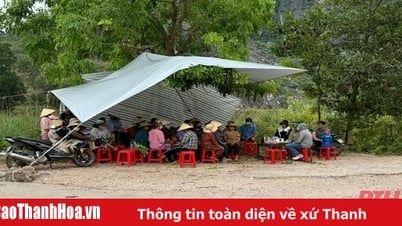

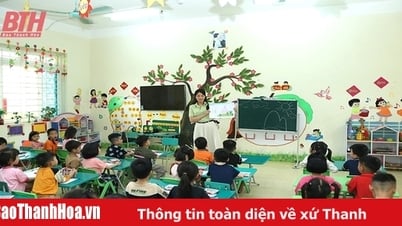






























































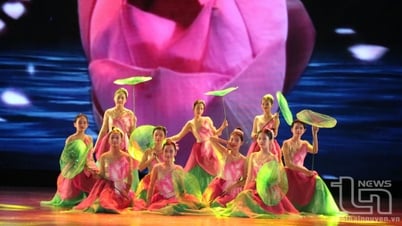

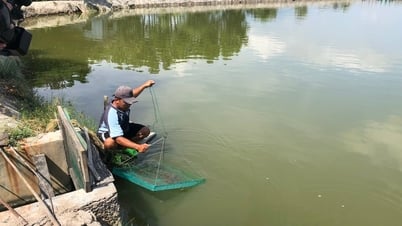

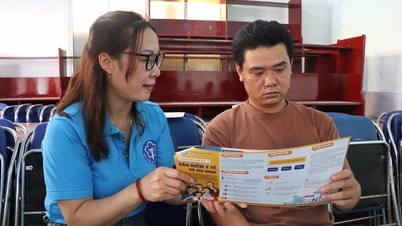
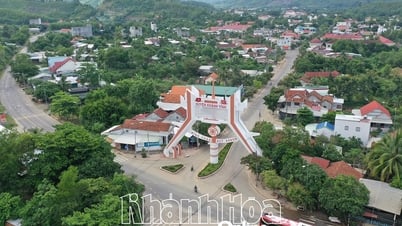










Comment (0)